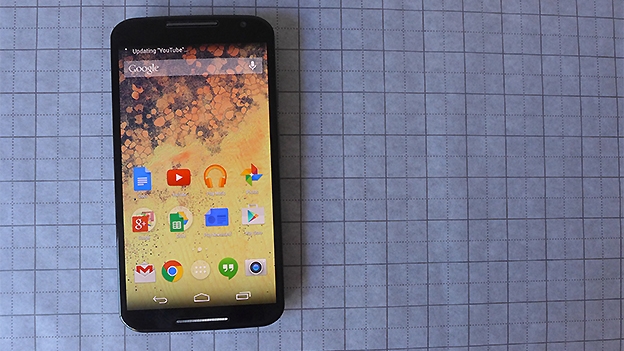Motorola Moto X (2014) review
Does bigger mean better for the new Moto X?

-
+
Fantastic build and feel
-
+
Moto Maker
-
+
Moto Display
-
-
Far from excellent camera
-
-
Battery life could be better
Why you can trust T3








Announced after a flurry of media hype and speculation, the original Moto X was a peculiar device. It didn't have the best screen, fastest internal specs or sharpest camera, yet it won over many with a sleek look and great in-hand feel.
But, a year on and Motorola is back for round two and this time it has got the specs to match the lofty ambitions, but has it got what it takes to come out on top against the Android big hitters like the Samsung Galaxy S5, HTC One M8, Sony Xperia Z3 and of course, Apple's iPhone 6? Let's take a look.
Look and feel
Pick up the Moto X and you can instantly tell why this this is one best-designed Android devices we've probably ever tested.
Just like last year's model, the back has a slight curve to it, complete with that trademark Motorola dimple, and it helps the phone sit perfectly in your hand. It feels natural to hold, unlike the iPhone 6 with its rounded edges that feel all too slippy.
It's not the lightest device; tipping the scales at 144g it's heavier than the 129g iPhone 6 but you've got to remember the screen is much larger here, at 5.2-inches as opposed the iPhone 6's 4.7-inch version.

The original Moto X was known, and applauded, for being fairly compact, and while the new model doesn't go down that route, the removal of the bezels gives this a new trick: it feels pretty much all screen in your hand, save for some speaker grilles above and below the display.
Our review unit came with a matte black back, that's soft to the touch, yet grippy enough for the device to feel secure. If you're looking for something more personal, the Moto Maker creation suite has come to the UK, so you can kit your Moto X out in everything from real wood to a genuine leather sourced from Chicago.
It's awesome. You should definitely check it out if you're willing to spend a bit more to personalise your new phone.
Continuing the theme of taking the original Moto X and cranking up the premium feel, Motorola has ditched the plastic rim, replacing it with an aluminium version. Apart from giving the whole device a classier look, it ramps up the sturdiness impressively. There's no give in the phone and we can say for sure there won't be any bending going on in your pocket.
Powerful internals
Under that beautifully designed exterior you've got a fairly standard set of internals for a high-end Android device, including a speedy Snapdragon 801 processor paired with 2GB RAM.
As it's running a basically stock version of Android, you'll find no Samsung-a-like skins here, which apart from being pleasing to the eye, also means you'll get a device that is almost completely free of slow-down and lag.
Opening up apps is quick, flicking through menus is smooth and the only time we had any trouble with speed was when you starting opening multiple tabs in Chrome. While it may be lacking the even quicker Snapdragon 805 that powers the Galaxy Note 4 and Nexus 6, the Moto X is definitely no slouch.
Display
Instead of the more commonly used LCD displays, Motorola has kitted the Moto X out with the Super AMOLED technology, similar to those used by Samsung on its high-end devices.

There's a very important reason why Motorola has stuck with this display tech and it's for one of the phone's best features - Moto Display.
Working in combination with four sensors on the front of the device, Moto Display shows you notifications when either you approach the device or wave your hand over it, lighting up just the pixels it needs. Only Super AMOLED displays posses the skill to just light up a few pixels and it saves battery as opposed to lighting up the whole screen. Moto Display has stopped us having to unlock the phone just to see if we have new emails, saving plenty of battery in the process.
We do love the Moto X display. It's 1080p, 5.2-inches with an impressive 423ppi and colours are ridiculously bright, if a little over-saturated.
Text is crisp and blacks look inky, just as we'd want, while viewing angles are especially impressive, but if there's one issue, it's that the screen on the whole is just a little pink for our tastes.
Whenever you're looking at light colours, the screen has a tendency to add a pink or reddish hue to everything. It's only a minor quibble, but it does take something away from the display.
Moto additions

We mentioned before that the Moto X comes running a near stock build of Android 4.4 Kit Kat (we've already had confirmation that the 5.0 Lollipop update will be coming soon after release) but that doesn't mean Motorola hasn't added any juicy extras.
Last year's version shipped with a nifty touchless way to interact with your phone, just say 'OK, Google Now' and it immediately burst into life, ready to set to any task you asked for. Moto Voice, as it's now called, is still here, though it has received a number of improvements this time around.
For one you can alter your starting phrase, ditching 'Ok, Google Now' for something more personal to you. As long as your phrase is a decent length (we went with the old-skool 'Hello Moto'), it works just fine and the Moto X will recognise only your voice and nobody else, once you've trained it up.
You can also now send a Whatsapp message completely with your voice, which is handy, though we still find something a little odd about having a full on conversation with our phone. Maybe that's just us.
Another nice addition is Moto Assist, which is sort of a souped up 'Do Not Disturb' mode. For instance, it'll mute all notifications between a set amount of hours in the evening, so emails won't disturb your slumber, and it'll read out texts messages you get when it senses you're driving.
It works seamlessly, though we would like a few more customisation options. Maybe you want to start receiving notifications at 7am on a weekday, but not until 11am on a Saturday? But sadly with Moto Assist, it's all or nothing.
Camera
A real let down on the original Moto X, the camera on the 2014 edition is a big improvement, but it's still nowhere near the standard set by other devices like the Samsung Galaxy S5 and iPhone 6.

So what's changed? Well, the megapixel count has been upped from 10MP to 13MP and 4K UHD video recording is now supported. An updated flash has also been added, which is housed in the rim of the camera. It's nice idea, but makes no difference to the quality of the flash and we'd still advise against using it unless it's completely necessary.
Pictures in daylight are sharp and look good, though as soon as light becomes scarce the quality drops significantly. Distortion is rife and blurry pictures are the order of the day. We tried to take countless low-light shots and none of them came out looking even worthy of an upload to Instagram.
From anywhere on the phone you can twist the device twice and the camera app will open, which is a nice touch, though it looks a little odd shaking your phone in public.
The camera app itself, another Motorola addition, is fast - just tap the screen to capture and settings are kept to a minimum. We'd still recommend downloading Google's Camera, but that does render the shake to open function redundant.
4K video looks great, but so does 1080p and we'd suggest sticking to that for now. Recording in 4K really takes up of storage and as this device only ships with 16 or 32GB and no MicroSD, you'll find yourself running out of space really fast.
Battery and call quality
If you're looking for a phone that can easily get you through a whole day, filled with calls, multiple emails and constant refreshes of your Twitter feed, the Moto X will not let you down. If you're looking for a phone to go multiple days without hitting the red, then you're probably looking in the wrong place.
We managed a day of use, no problem, from the 2,300 mAH battery and we'd end up plugging it in with about 15% of the juice left over. If you're a less frequent user and don't have lots of email accounts syncing with WiFi and Bluetooth on all the time, you'll get about a day and a half of use.
Call quality, on Three's network, was about the same as you'd expect from a smartphone. It's not crystal clear, yet there's a decent kick of volume and we never had any problems hearing people on the other end of the line.
Verdict
The Moto X is a fantastic Android device, possibly one the best out there at the minute. It's clear so much time has gone into creating a phone that not only performs admirably, yet that's also a pleasure to use and even to hold in your hand. The plethora of customisation options are a nice addition too, letting you create a device that is truly yours.
We respect Motorola a lot for sticking with stock Android, ditching those slow skins and promising a quick update when Android 5.0 Lollipop hits. Lollipops adds such an array of exciting new features that buying a phone that might not get the update until next year just doesn't sound good to us at all.
If you've picked up a Nexus devices in the past, but don't want to go all out phablet with the Nexus 6, the Moto X is probably the closest thing you're going to get to a new mid-size Nexus device, and a fantastic one at that.
We still wish Motorola, just like HTC, could work out how to make a decent phone camera and the battery is definitely not amongst the best out there, but these are only minor quibbles and not enough to put us off in the slightest.
Motorola Moto X price: £419.99
Motorola Moto X release date: Out now
Sign up to the T3 newsletter for smarter living straight to your inbox
Get all the latest news, reviews, deals and buying guides on gorgeous tech, home and active products from the T3 experts
-
 Amazon just gave some Kindle Scribe owners a welcome AI upgrade
Amazon just gave some Kindle Scribe owners a welcome AI upgradeThe new device's AI features are coming to UK users
By Max Freeman-Mills Published
-
 New Piaget Polo features a tourbillon and a moonphase – and looks great doing it!
New Piaget Polo features a tourbillon and a moonphase – and looks great doing it!The classic watch is given a theatrical new look
By Sam Cross Published
-
 First electric Ferrari to be revealed in October this year
First electric Ferrari to be revealed in October this yearThe Italian supercar maker says its Sir Jony Ive designed EV is just eight months away
By Alistair Charlton Published